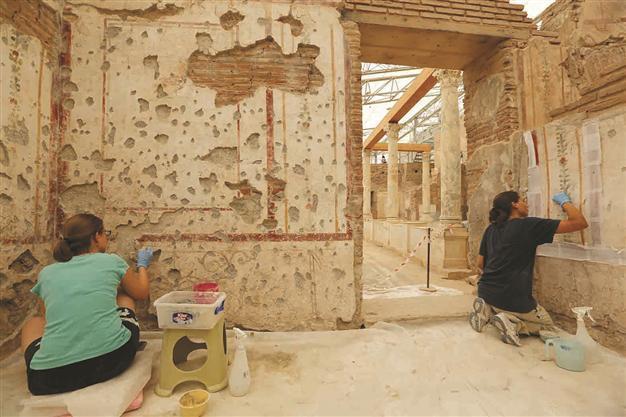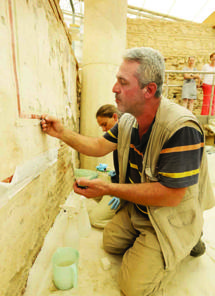Centuries-old Ephesus paintings restored with latest technology
İZMİR - Doğan News Agency

The fantastic mosaics and wall paintings of the Yamaç Houses in Ephesus are undergoing a new restoration that will leave the works as vivid as the day they were created back in 1 BC
Magnificent wall paintings dating back 2,000 years in the Yamaç Houses of the ancient city of Ephesus are undergoing a restoration to return them to their original glory.
“Touching a 2,000 year-old work, and preserving it for the next 2,000 years gives you a charge,” said Hasan Savaşer, who has been working on restorations in the area for the past 23 years.
The ancient city of Ephesus is visited by nearly 2 million tourists every year. The Yamaç Houses, which were the abodes of the rich built on terraces on the skirts of Bülbül Mountain in 1 B.C., are famous for wall paintings and floor mosaics ancient city.

The wall paintings were restored following excavations in 1977. In 2010, a new process started for the paintings to be restored with the latest technology. As part of the works, 120-square-meter wall paintings in eight rooms were restored this year.
The restoration project is being conducted with the permission of the Culture and Tourism Ministry General Directorate for Cultural Heritage and Museums under the scientific consultancy of the Austrian Archaeology Institute and with the sponsorship of the Ephesus Foundation. The walls, decorated with historical paintings, were strengthened and cleaned with special chemicals. Revitalized with retouch dyes, the paintings are being restored as close as possibility to the original from 2,000 years ago.
“The excavation and restoration was made in 1977 but the walls became dirty. Using the latest restoration techniques and chemicals, we are returning the wall paintings and floor mosaics almost to their original. After reinforcing the wall, we will clean the dirt layer and complete some paintings, without changing the original tissue. The goal here is not to interfere with the painting, but to create wholeness with small touches. Because of detailed working, a wall takes two months,” Savaşer said.
Among 20 restoration experts, who are considered the world’s best ones in their field, Savaşer’s career trajectory stands out most prominently. Just a primary school graduate, the 47-year-old Savaşer came to Ephesus in 1991 to transport earth with a wheelbarrow.

Savaşer, who defines himself as an “uneducated restoration expert,” said one of the world’s most difficult restoration process had been carried out in the Yamaç Houses and that passionate people there were demonstrating their talent.
“I got involved with this job in 1991 when I was 24. I helped the excavation team in the beginning. We were digging earth with digging tools,” he said.
“As time went by, I began to understand what was going on here. I began to be interested in archaeology and to be excited for each work unearthed and each column restored. This place is a school at the same time. If you like this work, experts here give you great support when they see that you want to learn. Even though I was a worker here, they gave me great support and through time I learned about restoration techniques. I take part in almost each stage of the restoration. Student groups come to see the restoration. Under the direction of the head of the excavations, I tell them what we are doing here and how the restoration is continuing,” Savaşer said.
He said the work was a lifestyle for him rather than a source of income, adding that workers ultimately became experts in certain fields.
He said people, who had spent many years in Ephesus, could not leave the ancient city and that many archaeologists even remained there after their retirement.

 The wall paintings were restored following excavations in 1977. In 2010, a new process started for the paintings to be restored with the latest technology. As part of the works, 120-square-meter wall paintings in eight rooms were restored this year.
The wall paintings were restored following excavations in 1977. In 2010, a new process started for the paintings to be restored with the latest technology. As part of the works, 120-square-meter wall paintings in eight rooms were restored this year.  Savaşer, who defines himself as an “uneducated restoration expert,” said one of the world’s most difficult restoration process had been carried out in the Yamaç Houses and that passionate people there were demonstrating their talent.
Savaşer, who defines himself as an “uneducated restoration expert,” said one of the world’s most difficult restoration process had been carried out in the Yamaç Houses and that passionate people there were demonstrating their talent.